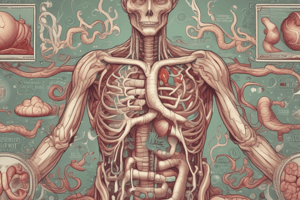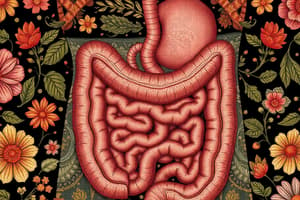Podcast
Questions and Answers
What is the inactive form of the protease that is secreted by the stomach?
What is the inactive form of the protease that is secreted by the stomach?
- Pepsinogen (correct)
- Bile
- Pepsin
- Chyme
Which organ secretes enzymes that are crucial for the digestion of carbohydrates, proteins, and fats?
Which organ secretes enzymes that are crucial for the digestion of carbohydrates, proteins, and fats?
- Large intestine
- Liver
- Pancreas (correct)
- Gallbladder
What is the role of sodium bicarbonate in pancreatic juice?
What is the role of sodium bicarbonate in pancreatic juice?
- To stimulate enzyme secretion
- To digest carbohydrates
- To emulsify fats
- To neutralize acidic chyme (correct)
What is bile primarily classified as?
What is bile primarily classified as?
Where does most digestion actually take place in the small intestine?
Where does most digestion actually take place in the small intestine?
What structures in the small intestine increase the surface area for absorption?
What structures in the small intestine increase the surface area for absorption?
What kind of mixture is chyme as it enters the small intestine?
What kind of mixture is chyme as it enters the small intestine?
What happens to undigested food in the digestive system?
What happens to undigested food in the digestive system?
What is the primary function of the digestive process in the mouth?
What is the primary function of the digestive process in the mouth?
Which substance is primarily responsible for lowering the pH in the stomach?
Which substance is primarily responsible for lowering the pH in the stomach?
What characterizes physical digestion?
What characterizes physical digestion?
What is the role of peristalsis in the digestive system?
What is the role of peristalsis in the digestive system?
Which of the following stages of nutrition directly follows ingestion?
Which of the following stages of nutrition directly follows ingestion?
Which glands are responsible for secreting saliva in the mouth?
Which glands are responsible for secreting saliva in the mouth?
What type of digestion occurs when food is transformed into smaller molecular components?
What type of digestion occurs when food is transformed into smaller molecular components?
Which component found in gastric juice is essential for protein digestion?
Which component found in gastric juice is essential for protein digestion?
Flashcards are hidden until you start studying
Study Notes
Nutrition
- Nutrition is how organisms get and utilize food.
Physical Digestion
- Breaking down food into smaller particles.
- Occurs in the mouth and stomach.
Chemical Digestion
- Breaking down of food into substances that can be absorbed by the blood.
Stages of Nutrition
- Ingestion: Taking in food.
- Digestion: Breakdown of food.
- Absorption: Passage of broken down food into the blood.
- Egestion: Removal of undigested material.
Digestive system
- The alimentary canal is a tube running from the mouth to the anus.
- It is a 25-30 foot long muscular tube.
- Includes organs like the liver and pancreas that secrete digestive juices.
- Digestive juices are fluids that break down food into molecular components.
Process of Digestion
- Mouth: Starts the digestion process.
- Chewing breaks down food physically.
- Salivary amylase breaks down carbohydrates chemically.
- Saliva is produced by three pairs of glands: parotid, submandibular, and sublingual.
- Esophagus: A long tube connecting the mouth and stomach.
- Uses peristalsis, rhythmic muscular contractions, to move food to the stomach.
- Stomach: A J-shaped, elastic organ.
- Churns food with gastric juices.
- Gastric juices contain hydrochloric acid and protease.
- Hydrochloric acid lowers stomach pH to 2, killing bacteria and activating protease.
- The inactive form of protease is pepsinogen, and it's activated by hydrochloric acid into pepsin.
- Small Intestine: Where most nutrient absorption occurs.
- Receives acidic chyme (food mixed with stomach secretions).
- Secretes enzymes for breaking down carbs, proteins, and fats.
- Pancreas: Secretes pancreatic enzymes, including amylase, proteases, and lipase.
- Pancreatic juice contains sodium bicarbonate, which neutralizes acidic chyme.
- Liver: Produces bile.
- Bile is concentrated and stored in the gallbladder.
- Bile isn't an enzyme, but an emulsifier that suspends fats in water, allowing enzymes to act on them.
- Duodenum: The upper section of the small intestine.
- Most digestion occurs here due to the presence of villi.
Small Intestine Structures
- Villi: Finger-like projections in the small intestine.
- Microvilli: Tiny projections on the villi.
- Single Layer of Epithelial Cells: These cells secrete protease and amylase.
Large Intestine
- Undigested food passes into the large intestine.
Studying That Suits You
Use AI to generate personalized quizzes and flashcards to suit your learning preferences.




